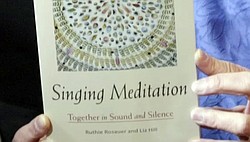SINGING MEDITATION
Singing Meditation

Singing can bring great joy say Ruthie Rosauer and Liz Hill, co-authors of Singing Meditation.
Spiritual companions blend song and silence
By LINDA M. LINONIS
religion@vindy.com
youngstown
Singing meditation blends song and silence to uplift the spirit and soothe the soul.
Ruthie Rosauer and Liz Hill, co- authors of “Singing Meditation,” will introduce the practice to Mahoning Valley residents during a program from 4:30 to 6 p.m. Sunday at First Unitarian Universalist Church, 1105 Elm St.
Rosauer of Eau Claire, Wis., and Hill of Boardman, who met about 20 years ago through a mutual friend, described themselves as “spiritual companions.” Hill’s husband, Matt Alspaugh, is pastor of First Unitarian and Rosauer belongs to a Unitarian church in Eau Claire. She described herself as a “traveling corporate spouse” who has lived in 11 states.
Both women said they loved to sing but had been discouraged in musical avenues. Rosauer said she took piano lessons as a youth and thought she was “mediocre” so she didn’t pursue any music in college. “I didn’t sing at all for about 15 years,” she said.
Hill said she often “mouthed the words.” Like many people, Hill said she knew she wasn’t “one of the top three voices” in a crowd and that competition kept her silent.
But life took a melodic turn when Rosauer spent time in 1998 at a spiritual community in Findhorn, Scotland, where Taiz prayer was practiced. Taiz , which follows Christian traditions, is a meditative candlelit service featuring simple chants.
Intrigued by the format of Taiz , Rosauer said she could see how Christian, Jewish, Sufi, earth-centered, Buddhist and nontraditional sources of songs could work well interspersed with silence to create singing meditations. “There are many paths to God,” Rosauer said of the interfaith aspect of the meditation.
Rosauer and Hill said chanting doesn’t require “a good voice.” “It’s about the joy of singing,” Rosauer said. But, she said, it’s amazing how “immediately beautiful” the effort is of those trying singing meditation. And they explained why this occurs. “The songs are short and easy to learn,” Hill said. Repetition draws people into physical movement of tapping a foot or swaying the body.
“People feel confident fairly quickly and relax into a song,” Rosauer said.
Rosauer said the program Sunday at the church will teach participants how a singing meditation works. She’ll use a piano as a “teaching tool,” but tambourines, drums and shakers also may be used or no instruments at all. Their Web site, www.singingmeditation.com, notes that a variety of vocalizations such toning, chanting, singing in rounds, singing in harmony and mantras, may be used.
Hill said the chantlike songs are repeated and then lapse naturally into silence. “I think the repetition helps quiet your mind and you can meditate or reflect,” Rosauer said.
Rosauer said a Jewish song, nigun, uses “nonsense” words. Think of “If I Were a Rich Man” from “Fiddler on the Roof,” she said. “Words are sometimes a stumbling block between God and man,” she said, so this type of song just eliminates that.
Another song might use a “round” technique, such as “Row, Row, Row Your Boat,” in which participants join the singing at various intervals. “When you get this going, it sounds like heaven,” Rosauer said. “It does sound really cool,” Hill added.
The simplicity of the easy-to-learn, repetitive songs helps people experience the music and immerse themselves in it.
Rosauer has written songs, including “Use Me” and “Cherish This Hour.” She, along with Helen Gierke, developed a songbook, "Let Joy Fill Your Heart: Songs for Singing Meditation.”
Rosauer presents workshops on singing meditation and she also has addressed national Unitarian conferences on the subject.
“Singing meditation helps people find a way to connect deeper into the God ... the divine,” Rosauer said.
 43
43
